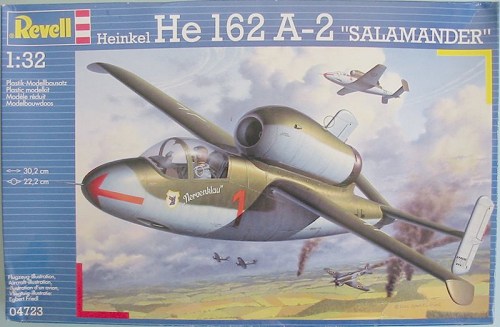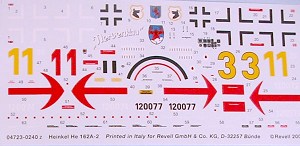
| KIT: | Revell AG 1/32 He-162A 'Salamander' |
| KIT #: | ? |
| PRICE: | $30.00 MSRP |
| DECALS: | Three options |
| REVIEWER: | Tom Cleaver |
| NOTES: |

| HISTORY |
The Heinkel He-162 “Salamander,” also known as Der Volksjaeger, is an example of the problem of the Nazis, that being that when they finally managed to wrap their minds around the reality-based world - as opposed to their faith-based worldview - the result was Too Little, Too Late. Had this airplane been designed as it was and produced as it was, as little as nine months earlier than it was, it could have had a real effect on the battle for air superiority over the Third Reich, though even with that the likely result would have been merely to postpone the inevitable by perhaps a year.
By the summer of 1944, it was obvious to everyone other than Adolf Hitler that a good defense was the only thing that could come between the Nazis and disaster. The Jaegerprogramm had finally rationalized German fighter production, to the point that the high point of monthly fighter production for the entire war was achieved in September 1944. Unfortunately, by that time there were few pilots of any ability to fly the masses of fighters, even if there had been the aviation gasoline to do so, the German supply of both natural and synthetic fuels having been knocked out decisively between June and August.
The He-162 was the result of a demand by Speer that a fighter of superior performance to Allied fighters, capable of mass production by unskilled labor, be created. It was also bally-hooed about that the pilots would be members of the Hitler Jugend, given basic training in gliders and turned loose in this “People’s Fighter.”Design was started on September 1, 1944. On September 23, a detailed proposal was presented to the Jagerstab. On October 28, construction of the first prototype began, and it flew on December 6, a record unmatched by any other combat airplane.
As Allied test pilots like Eric Brown would later discover, the diminutive fighter did have good performance and maneuverability, after some modifications of the original design - including a change to the inner trailing edge of the wing to insure that stall began at the wing root, adoption of turned-down wing-tips for stability, and larger vertical fins and rudders to improve directional stability and create an effective gun platform.
There was no way that masses of semi-trained German teenagers were going to man this airplane, however. It was a handful, demanding of good piloting ability, as Heinz Baer and his pilots in Erprobungskommando 162 discovered, as well as the experienced fighter pilots of I/JG1 who were recalled from the Eastern Front in February 1945 and transitioned to the He-162 over the next six weeks, being declared operational on April 8, 1945.
The airplane fully lived up to the requirement it be easily produced, with several hundred produced in underground factories where the majority of the airframe that was made of wood was assembled by workers who months previously had been building furniture.
An RAF Tempest is allegedly the sole combat victim of the He-162, being shot down over northwestern Germany in late April.
Following the German surrender on May 8, 1945, the British took over the field where I/JG1's He-162s were collected. RAF personnel went through the fighters and picked the ten best, which were taken to England and subjected to flight testing in the fall of 1945.
Three of these ten were sent to the United States, arriving at Freeman Field, Indiana, in early 1946. One of these, Wk. Nr. 120077, was taken to California and flight tested at Muroc Dry Lake flight test center during that year. Several years later, the airplane was presented to Kansas State University, where it was purchased in the late 1950s by a collector who later sold it to Ed Maloney in 1961 and it was taken to the Planes of Fame Museum in Chino, where it is now one of the first airplanes a visitor passes as they walk through the Tom Friedkin Hangar on their way out to the tarmac. One other of the three is on display at the Air Force Museum, on loan from the Smithsonian.
| THE KIT |
 When one opens the box, it is immediately apparent that this kit has been
produced “for a price.” Studying the parts on the four sprues of light blue
plastic and one of clear plastic (not shown), one is struck by the fact
there is more detail in the 1/48 DML kit.
When one opens the box, it is immediately apparent that this kit has been
produced “for a price.” Studying the parts on the four sprues of light blue
plastic and one of clear plastic (not shown), one is struck by the fact
there is more detail in the 1/48 DML kit.
This is particularly true with regard to the cockpit and the engine. While the He-162 cockpit is in fact quite simple, I can tell you as someone who has looked inside the cockpit of Wk.Nr. 120077 - the 1:1 airplane from which this model was created - that there is more detail to be seen than is provided in this kit. And in 1/32, the little He-162 is big enough that even scaling up the detail of the 1/48 DML kit - particularly as regards the ejection seat - would be an improvement to what is here, with a seat molded to the rear bulkhead and minus most of the detail I would expect in a kit this size.
The same is true of the engine, which will look good from a distance of a couple feet, but not close up. Again, more separate detail of the engine is provided in the DML kit.
Do not assume from the above that I don’t like the kit. I do think they made it just a bit too cheaply. I think a unit price of maybe $38-$40, with the additional cost put into producing detail in these two areas by not over-simplifying things, would not be met with screams from the customers. As it is, those who want to open the canopy or the engine cowling will want to see what the resin aftermarket suppliers create.
Comparing the kit with the real thing out at Chino, it is obvious Revell
got it right about the airframe shapes and sizes. The flying surfaces are
all very well done, with razor-sharp trailing edges. The wheel wells
provide almost as  much
detail as does the DML kit, and this is completely acceptable.
much
detail as does the DML kit, and this is completely acceptable.
Decals are provided for three aircraft from JG1, all airplanes that survived to be taken over by the Allies; the sheet lacks swastikas, but 1/32 Bf-109 swastikas are approximately the right size for this model and otherwise the sheet is excellent. Wk.Nr. 120077 - which by the way is still in its original Luftwaffe paint, including the original unit and personal markings - is one of these, and will be the one I do for the review, since this model will eventually end up in the Planes of Fame Model Museum a few minutes’ walk from its original inspiration.
| CONCLUSIONS |
The kit provides the basis for a good model and is reasonably priced. Detail is deficient in the cockpit and engine for a kit this scale, but closing up the canopy and the engine cowling will solve that for those who won’t want to pony up the price of aftermarket replacements. Judicious painting of the engine could result in a good “one footer” if you want to display the engine open.
Thanks to Hannant’s for the review copy
If you would like your product reviewed fairly and quickly by a site that has nearly 300,000 visitors a month, please contact me or see other details in the Note to Contributors.